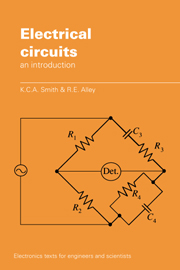Book contents
- Frontmatter
- Contents
- Program listings
- Preface
- 1 Basic concepts, units, and laws of circuit theory
- 2 Theorems and techniques of linear circuit analysis
- 3 Alternating current circuits
- 4 Power and transformers in single-phase circuits
- 5 Three-phase alternating current circuits
- 6 Transient and steady-state analysis
- 7 Non-linear circuit analysis
- 8 Two-port networks
- Appendices
- Bibliography
- Answers to problems
- Index
8 - Two-port networks
Published online by Cambridge University Press: 05 June 2012
- Frontmatter
- Contents
- Program listings
- Preface
- 1 Basic concepts, units, and laws of circuit theory
- 2 Theorems and techniques of linear circuit analysis
- 3 Alternating current circuits
- 4 Power and transformers in single-phase circuits
- 5 Three-phase alternating current circuits
- 6 Transient and steady-state analysis
- 7 Non-linear circuit analysis
- 8 Two-port networks
- Appendices
- Bibliography
- Answers to problems
- Index
Summary
Introduction
Networks are frequently encountered in electronics, control and communication systems in which an input signal is impressed at one pair of terminals and an output signal is taken from another pair of terminals; such networks are called two-terminal pair networks or, more frequently twoport networks.
The resistance voltage divider, first introduced in section 2.2, is an example of an elementary two-port network, and many other examples have occurred in the intervening chapters. In particular, it was demonstrated in section 7.3.2 that a non-linear device such as the transistor could, for small-signal conditions, be modelled by linear, two-port network. The concepts relating to such networks are therefore of considerable generality, and in this chapter we examine the theory of two-ports in greater detail and introduce further applications.
The theory contained in this chapter is concerned with the functional relationships among the voltage and current variables at the two ports of the network as defined in fig. 8.1. If the variables are steady-state a.c. quantities, then these relationships are formulated in terms of impedances or admittances. These same relationships will, of course, apply if the variables are transformed variables; in this case impedances and admittances are generalized functions of complex frequency as defined in chapter 6. In the case of purely resistive networks the functional relationships among variables are identical in form for instantaneous and d.c. quantities as well as for a.c. quantities. It should also be noted that the same relationships apply for incremental (small-signal) a.c. quantities as defined in section 7.3.1.
- Type
- Chapter
- Information
- Electrical CircuitsAn Introduction, pp. 501 - 541Publisher: Cambridge University PressPrint publication year: 1992
- 1
- Cited by

